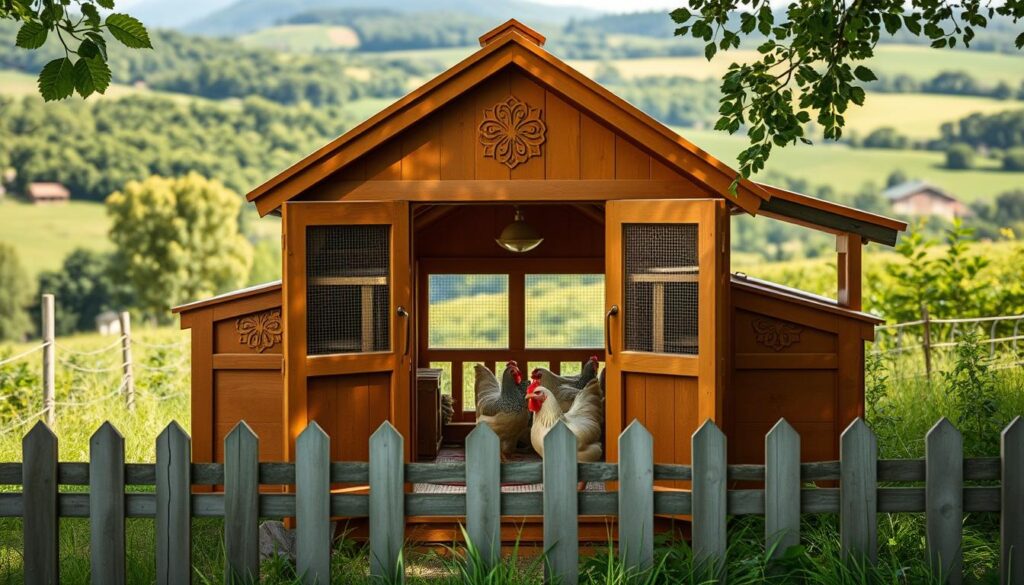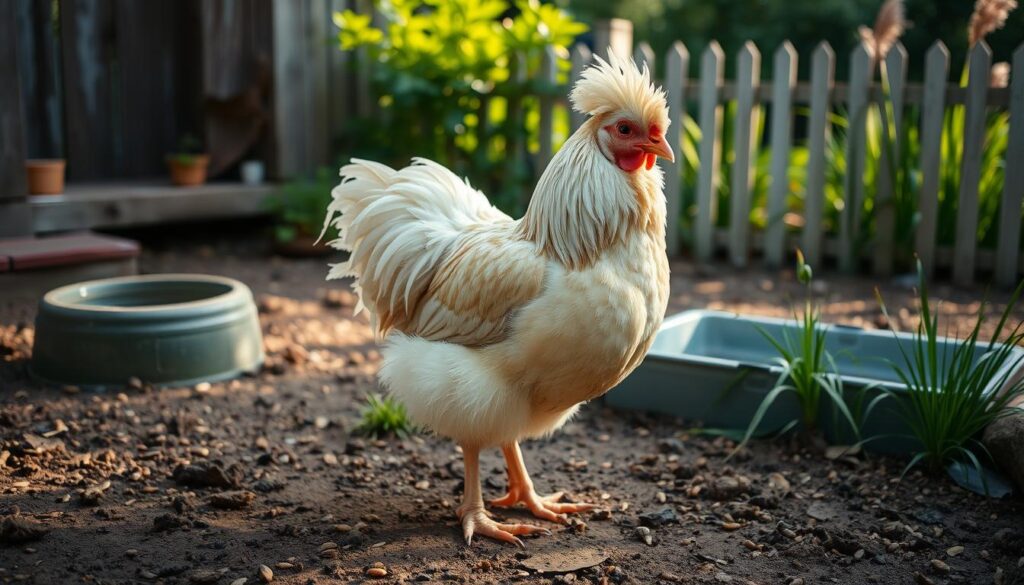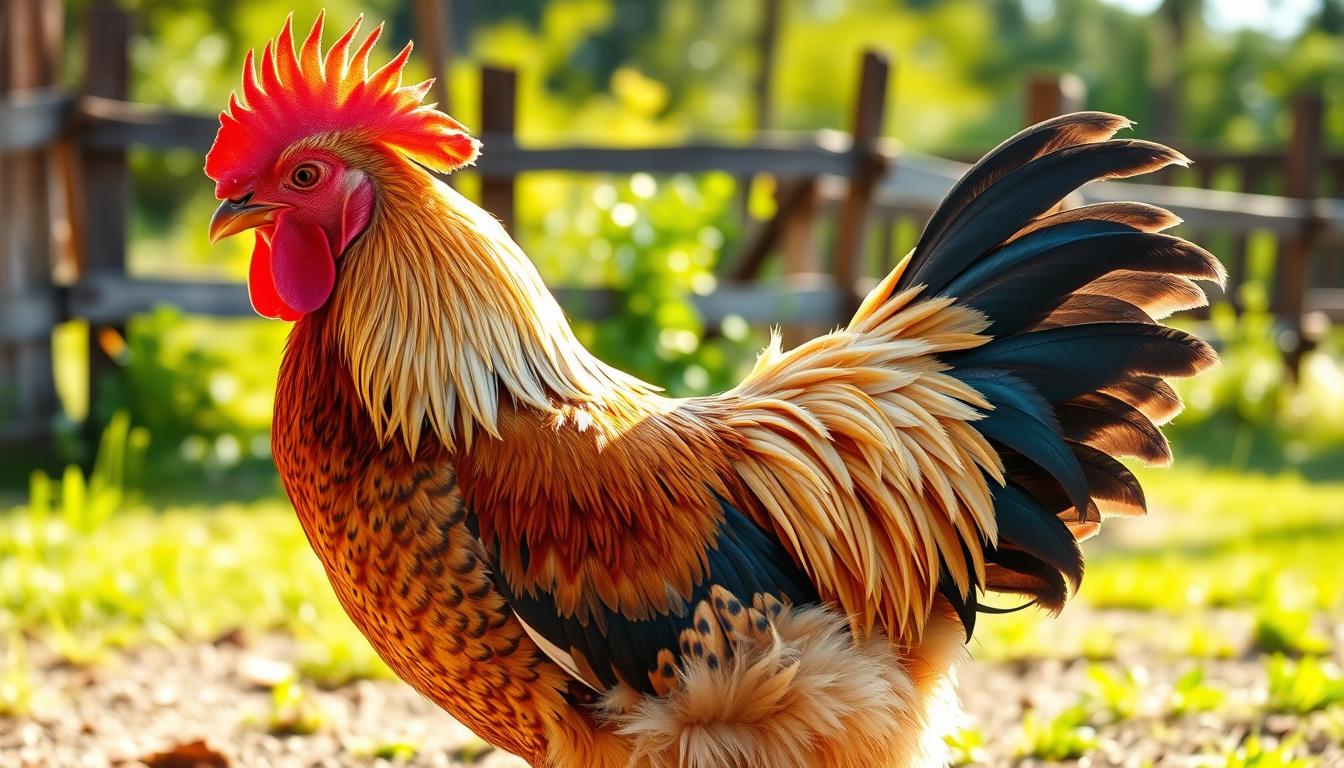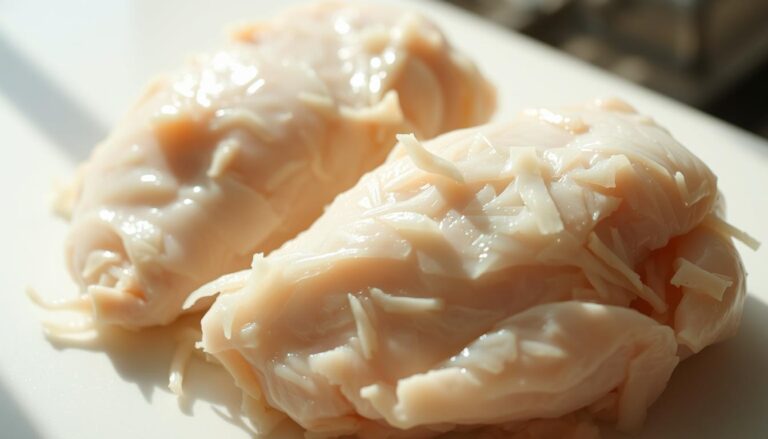Discover Buff Laced Polish Hen: Traits & Care
Table of Contents
Discover Buff Laced Polish Hen: Traits & Care
Looking for a unique and eye-catching addition to your flock? The Buff Laced Polish Hen stands out with its golden buff feathers and delicate laced patterns. This rare heritage breed is prized for both its beauty and practicality.
Known for their gentle nature, these chickens make excellent backyard pets. Their signature crest feathers require extra care but add to their charm. While they lay a modest 150 white eggs per year, they truly shine as exhibition birds.
Recognized in the APA Standard of Perfection, this breed holds a “Recovering” conservation status. With proper attention, they thrive in small flocks and bring elegance to any coop.
Key Takeaways
- Striking golden buff feathers with intricate lacing
- Docile temperament, ideal for backyard flocks
- Moderate egg production (150 white eggs/year)
- Requires special care for crest feathers
- Recognized heritage breed with conservation status
What Is a Buff Laced Polish Hen?
With their regal crests and intricate feather patterns, these chickens are living art. Their story weaves through centuries, blending mystery and meticulous breeding.
Origin and History
Debate surrounds their roots. Some tie them to 15th-century Dutch paintings, while others suggest Mongol or Spanish origins. Dutch breeders likely refined the breed, but its true ancestry remains unclear.
Their crests, supported by bony skull protrusions, hint at ancient lineage. Bearded and non-bearded varieties emerged, each with unique charm.
Physical Characteristics
Roosters weigh 6 lbs, hens 4.5 lbs, with striking slate-blue legs and *V-shaped combs*. The buff lacing—a creamy base with golden edges—creates a mesmerizing effect.
Their head crests demand attention, often obscuring vision. Beard variations add another layer of distinction.
Breed Recognition and Standards
The APA recognized bearded varieties in 1883 and non-bearded in 1938. Key standards include:
- Weight classes: 6 lbs (roosters), 4.5 lbs (hens)
- Comb type: V-shaped, neat
- Leg color: Slate-blue, smooth
Today, they’re prized in exhibition circles for their elegance and rarity.
Buff Laced Polish Hen Traits and Temperament
These elegant birds bring both beauty and personality to any backyard. Their golden feathers and playful crests make them instant favorites, but their behavior is just as captivating.
Personality and Behavior
Despite their docile nature, these chickens can be skittish. Their crests often block vision, making them easily startled. They thrive in calm flocks and bond well with gentle breeds like Cochins.
Unlike aggressive layers, they prefer leisurely exploration. Provide shaded areas to help them navigate safely.
Egg Production and Broodiness
Expect about 150 white eggs annually, but they start laying later than breeds like Leghorns. Their fertility rate ranges from 40–55%, requiring a 7:1 hen-to-rooster ratio for optimal results.
They rarely go broody. If you want chicks, consider using an incubator or surrogate mother.
Unique Features: Crest and Feathers
The crest feathers are their crowning glory—literally. A genetic quirk causes extra skull protrusions to support the fluffy crown. Regular trimming prevents matting and improves visibility.
- Feather care: Check for mites and debris weekly.
- Vision tips: Keep feeders and perches in predictable spots.
How to Care for Your Buff Laced Polish Hen
Proper care ensures your striking poultry thrives in any setting. These birds need tailored solutions for their signature crests and delicate feathers. Follow these guidelines to maintain health and beauty.

Housing and Coop Requirements
Provide 4 sq ft of coop space per bird with 2-4 ft roosts. Their limited vision makes predictable layouts essential. Keep feeders and waterers in fixed positions.
Ventilation prevents damp head feathers in winter. Below 40°F, use dry bedding to avoid frostbite. Consider heated waterers in freezing climates.
Feeding and Nutrition
Choose 18-20% protein feed for optimal feather and egg production. Supplement with calcium for strong shells. Their smaller size (4.5 lbs for hens) means adjusted portion sizes.
Offer grit for digestion and occasional treats like mealworms. Always provide fresh water—their crests can dip into bowls, so use narrow containers.
Health and Common Issues
Check crests weekly for lice or mites. Trim overgrown feathers or tie them back gently. This improves visibility and reduces predator risks.
Watch for respiratory issues—their unique skull structure makes them prone to infections. Isolate sick birds immediately. Schedule annual vet checks for parasite control.
- Winter care: Apply petroleum jelly to combs in freezing weather
- Summer tips: Provide shaded dust baths for cooling
- Predator proofing: Install hardware cloth and secure coop doors
Practical Tips for Raising Buff Laced Polish Hens
Their unique needs demand tailored approaches for a thriving backyard flock. While beautiful, these ornamental chickens require specific handling techniques and environmental adjustments due to their signature crests.

Handling and Socialization
Always announce your presence with soft talking before touching these birds. Their limited vision makes sudden movements frightening. Spend 5-10 minutes daily hand-feeding treats to build trust.
When introducing new chickens, quarantine first for two weeks. Then use a wire divider in the coop for gradual introduction. This prevents stress in your existing flock.
Protecting Their Crest and Vision
Trim crest feathers monthly to maintain 1-inch length around the eyes. Use sharp scissors and have a helper hold the bird steady. For shows, some owners craft soft fabric crest protectors using this simple pattern:
- Cut two semicircles (6″ diameter) from breathable fabric
- Sew elastic edges to create a gentle headband
- Use only during transport or extreme weather
Position feeders and waterers at chest height. This prevents messy crests and helps them locate resources easily.
Seasonal Care Considerations
Summer demands shaded areas covering 30% of the run. Freeze watermelon slices as cooling treats. Bearded varieties handle heat slightly better than non-bearded ones.
In winter, use coop heaters when temperatures drop below 20°F. Apply coconut oil to combs weekly to prevent frostbite. Increase protein intake by 10% during cold months.
Remember their flying ability—always cover runs with netting. Perches should be no higher than 3 feet to prevent crest-damaging falls.
Conclusion
Owning these golden-feathered beauties is like having a masterpiece in your backyard. The buff laced variety blends artistry with function, offering moderate egg production and exhibition-worthy looks.
Support conservation by sourcing from trusted hatcheries like Cackle®. Plan ahead—these birds reach full maturity at 20 weeks, ideal for show prep. Most breeders ship between February and August.
Perfect for patient keepers, this rare breed rewards extra care with unmatched elegance. Ready to elevate your backyard flock? These chickens deliver beauty and charm in equal measure.
FAQ
Where did the Buff Laced Polish Hen originate?
How many eggs can you expect from this breed annually?
What makes their crest feathers special?
Are they suitable for cold climates?
What size coop do they need?
How do you maintain their feather quality?
What colors are recognized in breed standards?
Are they good for beginners?
For more cooking tips, stay connected with us. We also recommend the cookbook Skinnytaste Simple: Easy, Healthy Recipes with 7 Ingredients or Fewer
For more Recipes about Chicken







